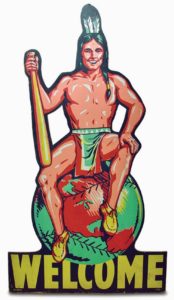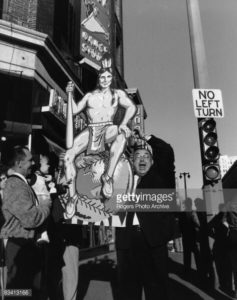THE SIGN

Height: 74”
Width: 42”
Thickness: 3/8”
Weight: Approximately 35lbs
Material/Construction: Pressed board; die cut.
Manufacturer: Carl Thelin Company
Origin/Purpose: Point of presence sign to welcome players, media, and fans to Milwaukee, Wisconsin for the 1957 World Series.
A survey of auction data shows that these four (4) examples have been offered since 2003.
OFFERED BY: Hunt Auctions, November 2016
DESCRIPTION: c.1950 Milwaukee Braves (6) foot tall “Welcome” sign. Likely served as a Stadium sign or was intended for use at a team related function.
PRICE: $952
OFFERED BY: Legendary; November, 2013.
DESCRIPTION: Large die-cut Milwaukee Braves “Welcome” sign, dating to 1957. (Condition issue with pencil drawing in of lines to resemble teeth).
PRICE: $329
OFFERED BY: Hunt Auctions; February, 2004
DESCRIPTION: Milwaukee Braves “Welcome” display piece c.1957-58.
PRICE: $192
OFFERED BY: Lelands, June 2003
DESCRIPTION: 1957 Milwaukee Braves World Series Street Sign.
PRICE: $1,585
Over the years, when I have asked about the origin of these signs, I have also been told that:
“It was a welcome sign for the Braves when they came from Boston in 1953.”
“It was used in conjunction with the 1955 All Star Game.”
While I have known exactly what these signs were for some time, I have always been interested and curious as to what others thought they were, especially in light of how they have been described when listed at public auction. That being said, what is confirmed through contemporary photographs by the Milwaukee Journal and Life Magazine (October 14th, 1957 edition) is that there were dozens of these signs produced and hung around Milwaukee for the 1957 World Series. We also know there was one 30 foot version that was manufactured as well (whereabouts/survival today unknown). Yet despite a fairly decent production run, few surviving examples have surfaced. Those that have survived are often found with condition issues ranging from portions of the sign having broken off, to having been drawn on, to even some that were used by less appreciative and mischievous youth as dart boards or targets.
In speaking with MEARS President Troy Kinunen about these signs, he informed me that even as someone who has lived in the greater Milwaukee area for decades and has actively collected, bought, and sold Milwaukee Braves memorabilia for an equal length of time, they are not as common as collectors might think. According to Kinunen, he and a previous local Milwaukee sports memorabilia partner had assembled a collection of six (6) of these back in the late 1990s/early 2000s. This was also about the same time that that the first of these pieces was sold to the larger collecting community via public catalog auctions. As noted above, less than a half dozen of these appear to have come up for auction and there is been great disparity in the pricing and information offered on them.
Apparent low survival rates for these 1957 World Series welcome signs may be attributed to any number of factors. Some the signs were likely damaged as they were removed from their original mountings as confirmed by Getty images.

“WELCOME” portion broken off when removed
We also know that these signs, once removed, figured prominently in the tumultuous and rowdy post-series fan celebrations. According to Ira Kapenstein, reporter for the Milwaukee Journal, “It (10 October, 1957) was the craziest night that Milwaukee had ever known.” Bob Wolf of the Milwaukee Journal also described the post-Game 7, 5-0 Braves clincher at Yankee Stadium as “New Year’s Eve and V-J day rolled into one.”
In his piece on the epic night of October 10th, 1957, Kapenstein estimates that by 9:00 pm (local time) there were 225,000 fans moving through and celebrating in the streets. “They marched up and down, singing, screaming, and carrying Indian posters (the signs) and flags they had ripped off light posts. Most waved either pennants or makeshift signs. Muscular young men carried shrieking girls on their shoulders. Impromptu conga lines and bunny hop lines wiggled in and out. Beer literally flowed through the streets as cans and bottles were smashed to the ground. The beer mixed with the confetti, paper, streamers, and torn up telephone books, covering the avenue with debris.”
I am sure there were a number of these signs damaged or discarded during the mayhem all along Wisconsin Avenue and across the city that night. Those that survived and made it to a fan’s home may have met other fates such as being used as targets, or simply discarded over time based on their size and or the passing of time as the Braves left Milwaukee after the 1965 season.
But what is it about these few surviving signs make them desirable or collectable, given they are not something that lends itself to easy display on a shelf or in a display case? For me, they have a number of factors in their favor:
- They are simply gorgeous artifacts.
- They are far from common or readily available, especially ones in nice condition.
- What they actually are is well documented in contemporary local and national media sources for those that bother to look.
- The nature of the event.
It is this last point that I will spend some time expounding upon. The 1957 World Series was only the second Fall Classic staged between 1947 and 1958 that was NOT won by a team from New York (the Cleveland Indians won the 1948 World Series). The 1957 Series also served as a national showcase for a twenty-three year old Hank Aaron. 1957 was Aaron’s breakout season in that he led the National League for the first time in runs scored (118) and the Major Leagues for home runs (44),runs batted in (132), and total bases (369). Aaron’s World Series performance was no less spectacular as he hit .393 with three homers and seven RBIs. All of this was enroute to his being the named the 1957 Most Valuable Player (MVP) in the National League… sort of Welcome Hank Aaron to the national stage if you will.
As a collectable or piece of baseball memorabilia, these signs can be categorized as a large die-cut piece. There have been a number of types and styles of “die cut” pieces sold over the years, and many at some staggering prices:
-1920s Babe Ruth die cut Sporting News advertising piece (price ranges from $28,000-$43,000)
-1955 Ted Williams die cut Sugar Crisp advertising piece ($14,500)
-c1935 Dizzy and Daffy Dean Beech-Nut Chewing Tobacco advertising piece ($14,340)
-c1928 Paul Waner Spalding advertising sign ($13,145)
These four examples have a number of things in common. They all feature Hall of Fame players; they are all of a size more suitable for display in space constrained environments; they are all graphically appealing; and as advertising pieces they all have no real historic connection to the players or events they depict. Unlike the 1957 Milwaukee Braves World Series signs, these other die cuts are advertising pieces that may have never been within one hundred miles of the players or events they portray. I am by no means suggesting or implying that these 1957 World Series Welcome signs should command the money that these above mentioned die cuts do, but only want to emphasize that these other die cuts are advertising pieces as opposed to one with a documented historic significance with respect to time, location, and event.
So what do I think these signs are worth? You could argue that they are worth somewhere between $192 and $1,585 because that is what they have sold for in the past. I tend to disagree with this line of logic or type “market analysis” since these previous public sales have done little to educate collectors on what the signs actually are, what the surviving population density might be and why, and what historical context they should be considered in. To me, unless the market is suddenly flooded with previous unseen examples that are relatively problem free, then I think (all things considered) these are more reasonably valued in the $2500-$3000 range for a quality example.
The purpose of me taking the time to write about these signs is not an attempt to drive up the price on them, (trust me, mine is not for sale as I have waited too long to get one) but rather to share some information on something I have been after for some time and many of the reasons why I think they are significant and underappreciated. For me, these signs provide a real, material, visual, and tangible connection to a place and time when Hank Aaron, Eddie Mathews, Warren Spahn, and the Milwaukee Braves sat proudly atop of the baseball world. I’ll take that over a sign peddling product any day of the week.
As always, collect what you enjoy and enjoy what you collect.
Dave Grob
davegrob1@aol.com
